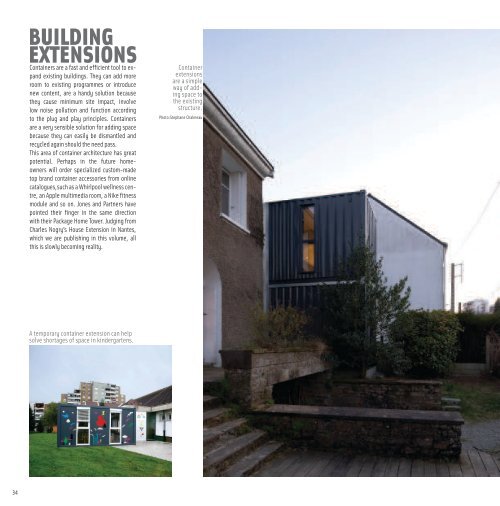pdf 1 - exhibitions international
pdf 1 - exhibitions international
pdf 1 - exhibitions international
Create successful ePaper yourself
Turn your PDF publications into a flip-book with our unique Google optimized e-Paper software.
BUILDING<br />
ExTENSIONS<br />
Containers are a fast and efficient tool to expand<br />
existing buildings. They can add more<br />
room to existing programmes or introduce<br />
new content, are a handy solution because<br />
they cause minimum site impact, involve<br />
low noise pollution and function according<br />
to the plug and play principles. Containers<br />
are a very sensible solution for adding space<br />
because they can easily be dismantled and<br />
recycled again should the need pass.<br />
This area of container architecture has great<br />
potential. Perhaps in the future homeowners<br />
will order specialized custom-made<br />
top brand container accessories from online<br />
catalogues,such as a Whirlpool wellness centre,<br />
an Apple multimedia room, a Nike fitness<br />
module and so on. Jones and Partners have<br />
pointed their finger in the same direction<br />
with their Package Home Tower. Judging from<br />
Charles Nogry’s House Extension in Nantes,<br />
which we are publishing in this volume, all<br />
this is slowly becoming reality.<br />
A temporary container extension can help<br />
solve shortages of space in kindergartens.<br />
Container<br />
extensions<br />
are a simple<br />
way of adding<br />
space to<br />
the existing<br />
structure.<br />
Photo:Stephane Chalmeau<br />
MIxED<br />
CONSTRUCTIONS<br />
AND SpICE-UpS<br />
Containers are certainly convenient and versatile; however,<br />
they do not offer a universal solution to every<br />
problem. Container architecture reaches a completely<br />
new level of potential when complemented with other<br />
construction materials such as wood, steel and concrete.<br />
This is particularly important for integrating containers<br />
into sloping terrain: most times concrete slabs will<br />
be used to even out the slope and containers are placed<br />
on top. Exterior cladding also helps improve container<br />
performance: timber slats, for instance, help protect<br />
them from overheating. Additional constructions can be<br />
used to support containers, lift them from the ground<br />
or set them apart to create large open spaces between<br />
them (cf. Manifesto House on p. 66 and the 12 Container<br />
House by Adam Kalkin).<br />
Sometimes architects and/or clients want to use containers<br />
not for the supporting structures, i.e. not to<br />
“build” something, but to spice things up and add additional<br />
flavour to their story. In such cases containers<br />
are usually statements in themselves.<br />
34 35<br />
The UniQlo<br />
container in<br />
Tokyo as a<br />
three-fold<br />
spice-up:<br />
entrance box,<br />
projecting<br />
roof, and<br />
changing<br />
cabins on the<br />
first floor. By<br />
LOT-EK.<br />
Photo: Danny Bright<br />
Container architecture hits a completely<br />
new level of potential when complemented<br />
with other construction materials such as<br />
wood, steel and concrete.<br />
Photo: Normand Rajotte










![01 -[BE/INT-2] 2 KOL +UITGEV+ - exhibitions international](https://img.yumpu.com/19621858/1/184x260/01-be-int-2-2-kol-uitgev-exhibitions-international.jpg?quality=85)






